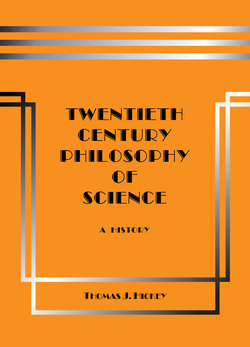Читать книгу Twentieth-Century Philosophy of Science: A History (Third Edition) - Thomas J. Hickey - Страница 68
На сайте Литреса книга снята с продажи.
3.37 Ontological Relativity Defined
ОглавлениеWhen metaphysical realism is joined with relativized semantics, the result is ontological relativity.
Ontological relativity in science is the thesis that the semantics of a theory or law and its constituent descriptive terms describe aspects of reality.
A scientific law is a tested and nonfalsified universally quantified statement that prior to its decisive testing had been a theory.
The ontology of a theory or law is as realistic as it is empirically adequate.
Understanding scientific realism requires consideration of ontological relativity. Ontological relativity is the subordination of ontology to empiricism. We cannot separate ontology from semantics, because we cannot step outside of our knowledge and compare our knowledge with reality, in order to validate a correspondence. But we can distinguish our semantics from the ontology it reveals, as we do when we distinguish logical and real suppositions respectively in statements. We describe mind-independent reality with our perspectivist semantics, and ontology is reality as it is revealed empirically more or less adequately by our semantics. Our semantics and thus ontologies cannot be exhaustive, but ontologies are more or less adequately realistic, as the semantics of descriptive language is more or less adequately empirical.
Prior to the evolution of contemporary pragmatism philosophers had identified realism as such with one or another particular ontology, which they erroneously viewed as the only ontology on the assumption that there can be only one ontology. Such is the error made by some physicists who believe that they are defending realism, when they defend the “hidden variable” interpretation of quantum theory. Such too is the error in Popper’s proposal for his propensity interpretation of quantum theory. As it happens, both Bohm and Heisenberg rejected the ontological thesis that the kind of existence familiar to us can be extrapolated into the atomic order of magnitude. And contrary to Einstein’s EPR thesis of a single uniform ontology for physics, Aspect, Dalibard, and Roger’s findings from their 1982 nonlocality experiments demonstrated empirically the Copenhagen interpretation’s semantics and ontology.
Advancing science has produced revolutionary changes. And as the advancement of science has produced new theories with new semantics exhibiting new ontologies, some prepragmatist scientists and philosophers found themselves attacking a new theory and defending an old theory, because they had identified realism with the ontology associated with the older falsified theory. As Feyerabend notes in his Against Method, scientists have criticized a new theory using the semantics and ontology of an earlier theory. Such a perversion of scientific criticism is still common in the social sciences where romantic ontologies are invoked as criteria for criticism.
With ontological relativity realism is no longer uniquely associated with any one particular ontology. The ontological-relativity thesis does not deny metaphysical realism, but depends on it. It distinguishes the mind-independent plenitude from the ontologies revealed by the descriptive semantics of more or less empirically adequate beliefs. Ontological relativity enables admitting change of ontology without resorting to instrumentalism, idealism, phenomenalism, solipsism, any of the several varieties of antirealism, or any other such denial of metaphysical realism.
Thus ontological relativity solves the modern problem of reconciling conceptual revision in science with metaphysical realism. Ontological relativity enables acknowledging the creative variability of knowledge operative in the relativized semantics and consequently mind-dependent ontology that are defined in constructed theories, while at the same time acknowledging the regulative discipline of mind-independent reality operative in the empirical constraint in tests with their possibly falsifying outcomes.
Or as manifested linguistically, using the relativized semantics and ontology partially defined by the theory “Every X is Y” it is possible to articulate the falsifying observational test outcome “This X is not Y” with the semantics defined by the test-design language, even though after issuing the falsifying observational statement the consequent revision of belief in the theory “Every X is Y” occasions a partial change in the rejected theory’s descriptive semantics and its ontological claim.
In contemporary pragmatist philosophy of science metaphysical realism is logically prior to and presumed by all ontologies as the primal prejudice, while the choice of an ontology is based upon the empirically demonstrated adequacy of the theory describing the ontology. Indulging in futile disputations about metaphysical realism will not enhance achievement of the aims of either science or philosophy of science, nor will dismissing such disputations encumber achieving those aims. Thus ontological relativity leaves ontology to the scientist rather than the metaphysician. And the superior empirical adequacy of a new law yields the increased truth of a new law and the increased realism in the ontology that the new law reveals.
